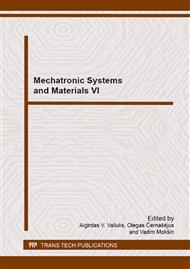[1]
D. Kotnarowska, M. Wojtyniak, Solid State Phenomena (Diffusion and Defect Data) 147–149 (2009) 825–830.
DOI: 10.4028/www.scientific.net/ssp.147-149.825
Google Scholar
[2]
D. Kotnarowska, Progress in Organic Coatings 67 (2010) 324–328.
Google Scholar
[3]
D.Y. Perera, Progress in Organic Coatings 28 (1996) 21.
Google Scholar
[4]
T. Nguyen, D. Bentz, E. Byrd, Journal of Coatings Technology 66(834) (1994) 39.
Google Scholar
[5]
T. Nguyen, D. Bentz, E. Byrd, Journal of Coatings Technology 67(844) (1995) 37.
Google Scholar
[6]
T. Nguyen, J. B. Hubbard, J. M. Pommersheim, Journal of Coatings Technology 68(855) (1996) 45.
Google Scholar
[7]
J.R. Kosek, J.N. DuPont, A.R. Marder, Corrosion 51(11) (1995) 861–871.
Google Scholar
[8]
S.P. Rigby, R.S. Fletcher, S.N. Riley, Chemical Engineering Science 59 (2004) 41.
Google Scholar
[9]
A. Webb Paul, An Introduction to the Physical Characterization of Materials by Mercury Intrusion Porosimetry with Emphasis on Reduction and Presentation of Experimental Data, Micromeritics Instrument Corp., Norcross, Georgia, (2001).
Google Scholar
[10]
Fu Xu Yong, Sun De' An, Physica A 316 (2002) 56.
Google Scholar
[11]
D. Kotnarowska, M. Przerwa, M. Wojtyniak, Journal of Vibroengineering 13(4) (2011) 870–876.
Google Scholar
[12]
D. Kotnarowska, Progress in Organic Coatings 31 (1997) 325–330.
Google Scholar
[13]
D. Kotnarowska, Mechanics and Mechanical Engineering 6 (3) (2002) 137–144.
Google Scholar
[14]
D. Kotnarowska D, Materials Science 12(2) (2006) 138–143.
Google Scholar
[15]
D. Kotnarowska, Materials Science 14(4) (2008) 337–340.
Google Scholar
[16]
D. Kotnarowska, Solid State Phenomena (Diffusion and Defect Data) 144 (2009) 285–290.
Google Scholar
[17]
D. Kotnarowska, Solid State Phenomena (Diffusion and Defect Data) 165 (2010) 91–95.
Google Scholar
[18]
O. Negel, W. Funke, Progress in Organic Coatings 28 (1996) 285–289.
Google Scholar
[19]
B. S. Skerry, C.H. Simpson, Corrosion 8 (1993) 663–674.
Google Scholar
[20]
S.J. Spadafora, H. Leidheiser, Journal of the Oil and Colour Chemists Association, Surface Coatings International (GBR) 71(9) (1988) 276–285.
Google Scholar
[21]
D. Kotnarowska, Journal of Corrosion Science and Engineering 6(051) (2003).
Google Scholar
[22]
D.R. Bauer, D.F. Mielewski, J.L. Gerlock, Polymer Degradation and Stability 38 (1992) 57–67.
DOI: 10.1016/0141-3910(92)90023-x
Google Scholar
[23]
D. Kotnarowska, Progress in Organic Coatings 37 (1999) 149.
Google Scholar
[24]
D. Kotnarowska, Solid State Phenomena (Diffusion and Defect Data) 113 (2006) 585–588.
Google Scholar
[25]
D. Kotnarowska, Influence of Ageing on State of Epoxide Coating Surface, in: Central European Coatings Show CECS'98, 21–23 October, 1998, Katowice.
Google Scholar
[26]
D. Kotnarowska, Journal of Corrosion Science and Engineering 2 (1999).
Google Scholar
[27]
D. Kotnarowska, M. Wojtyniak, Physico-Chemical Mechanics of Materials (Special Issue Lviv) 1 (2000) 298.
Google Scholar


